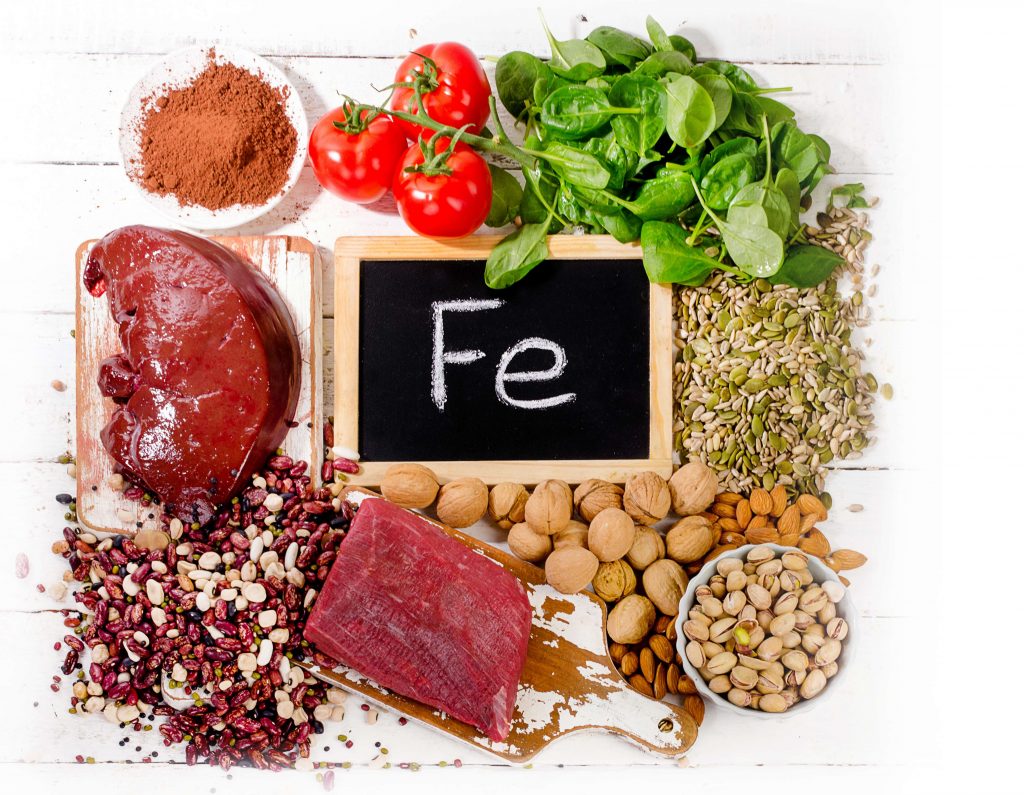
How common is iron deficiency anaemia?
Iron deficiency is one of the most common nutrient deficiencies in the UK, especially among women. Iron deficiency can lead to anaemia, which may be asymptomatic at first, but can lead to fatigue, weakness palpitations or dizziness. I am astonished this is not picked up earlier in so many of my clients.
Women are particularly at risk, due to blood loss through menstruation, pregnancies in close succession and childbirth. Those following a vegan or vegetarian diet are also at higher risk. Athletes may also be more prone to iron deficiency. This is thought to be due to micro-damage to the red blood cells when our feet strike the ground in conjunction with small losses through sweating.
Red blood cells have a life-cycle of around 120 days. We have around 5 million blood cells per 1mm³ , This might mean that we are replacing somewhere between 2-10 million red blood cells per second!
What is anaemia?
Anaemia is a condition where we lack iron. Because iron helps us carry oxygen around the body, a lack of iron can make it harder for our organs and muscle tissue to get sufficient oxygen. As a result, people can experience symptoms such as fatigue, weakness, and shortness of breath.
Iron deficiency anaemia is different to the anaemia caused by a deficiency in B12 or folate. These B vitamins are also important for red blood cell formation and a lack of these 2 vitamins can result in a type of anaemia called megaloblastic anaemia, where the red blood cells can enlarge, causing further difficulties in getting oxygen around the body. These 2 conditions are different, however this highlights why we need both iron, B12 and folate for healthy blood cell production
Symptoms of iron deficiency can include:
✳️ Tiredness
✳️ Increased infections
✳️ Dizziness
✳️ Weakness
✳️ Pale skin and gums
✳️ Poor concentration
✳️ Hair loss
✳️ Apathy
✳️ Irregular heartbeat
 Why do we need iron?
Why do we need iron?
-The body contains around 4g iron.
-Iron forms part of our haemoglobin, which is the oxygen-carrying component of the red blood cell.
-Red blood cells pick up oxygen from the lungs and distribute the oxygen to tissues throughout the body. If we lack iron, we will produce less haemoglobin, and therefore supply less oxygen to our tissues.
-Iron is also an important constituent of another protein called myoglobin. Myoglobin, like haemoglobin, is an oxygen-carrying molecule, which distributes oxygen to muscles cells, especially to skeletal muscles and to the heart.
-Iron is needed to manage ENERGY in the mitochondria
-Iron works as a co-factor in many chemical reactions in the body, including thyroid hormones.
-Iron works with anti-oxidant enzymes in the human body acting as a co-factor, such as catalase.
Iron is involved in the production of carnitine, a non-essential amino acid important for the proper utilisation of fat. The function of the immune system is also dependent on sufficient iron.
-Iron is required for a number of vital functions, including growth, reproduction, healing, and immune function as well as DNA synthesis, again by driving the enzymes that perform these functions.
-Iron is necessary for the production of antibodies, enzymes and white blood cells.
-Iron is needed for the detoxification of some drugs and bacterial toxins.
-On the flip side, too much iron can also suppress the immune system, so we need just the right amount.
Testing for iron deficiency
One of the biggest problems is that while our Haemoglobin on our blood test often looks in range, when we look deeper at iron saturation and ferritin (iron stores) we may see a very different picture. For example our ferritin can be in normal range between around 13-150 mcg/L for women and 30-400 for men. This means that the vast majority of people will have levels within this range, but because the range is so broad, they may not be in optimal range.
While this is NORMAL it may not be optimal. Optimal iron levels are around 70-100mcg/L . It is important to have a health professional look at your results who can evaluate your results correctly. Many women I see in clinic have ferritin levels sub 30. While this is in range, they may not be feeling like they are firing in all cylinders and may not be optimal.
In clinic we measure haemoglobin, transferrin saturation as well as ferritin to give us a better picture of what is happening beneath the surface.
How much iron do we need each day?
Women 14.8mg
Women post-menopause 8.7mg
Men 8.7mg
Which foods contain iron?
Iron is found in both the animal and plant kingdom, however, iron is better absorbed from animal food in its haem form. While plants do contain iron, levels are lower, so that we need to eat more iron rich foods to reach our daily requirements. Studies vary, but it is thought that we absorb between 15-35% of haem iron. Non-haem iron from plants is slightly harder for us to absorb than haem iron.
Iron is found in red meat, darker poultry, seafood, especially clams, lentils, beans, dark green vegetables, seaweed, nuts and seeds as well as dried fruits, dark chocolate or cacao and molasses. The darker the food, generally the more iron it may contain.
Iron is found in the following foods. I have listed them with the richest sources at the TOP of the list.
- Liver
- Dark chocolate / Raw Cacao nibs
- Clams
- Sesame seeds
- Egg yolk
- Red lentils
- Sunflower seeds
- Cashew nuts
- Pecan nuts
- Dark treacle
- Almonds
- Walnuts
- Red meats
- Sardines
- Soya beans
- Dried figs
- Dried fruits
- Quinoa
- Oatmeal
What increases iron absorption?
-Vitamin C increases iron absorption
-Vitamin A and beta carotene enhance iron absorption
What can decrease iron absorption?
– Foods that are high in phytates, such as whole grain breads, cereals, legumes, nuts, and seeds.
– Polyphenols and tannins found in tea or coffee
– Calcium can inhibit the absorption of both haem and non-haem iron
– Zinc, manganese, and copper also compete with iron for transport into the bloodstream
– Low stomach acid
– Certain medications, such as PPI’s/ Antacids may reduce absorption in some people
– Inflammatory gut conditions, such as coeliac disease or Crohn’s disease may reduce absorption
Supplementing iron
A qualified practitioner can weigh up the correlation between all the iron blood values to decide when supplementation is necessary, and also if extra folate or B12 should be give additionally, as we know these are also required for the formation of red blood cells. Iron levels improve slowly, so it can take a while to get back into a normal range. The reason we generally need supplements to counteract a deficiency is because it is quite difficult to raise iron levels quickly enough from food alone.
Iron supplements come in different forms and it is worth saying that many iron supplements are difficult to digest and can lead to nausea and constipation.
The cheapest forms of iron are usually in the form of iron sulphate or fumarate. These are the forms we are likely to be given on prescription. While these forms do work, they are not as well absorbed as other forms (see below).
❌ Iron sulphate and iron fumarate can correct iron deficiency, but are given in larger doses as they are not as well absorbed as other forms of iron
❌ Iron sulphate and iron fumarate can lead to digestive issues, such as dark, tar-like stools, nausea, constipation and abdominal discomfort.
✅ Many nutrition professionals prefer to use more natural forms of iron, these are often better absorbed, gentler on the gut and have less side effects.
✅ Iron bisglycinate is a gentler form of iron and is better absorbed than iron sulphate or fumarate.
✅ I like to supplement iron in a form that also contains vitamin C, vitamin B12 (methylcobalamin), Vitamin B6 (in P-5-P Form) and folate (as methyltetrafolate). These are some of the co-factors that work with iron in the body.
✅ I also sometimes use an oral spray that is absorbed through the gums.
There are lots of iron supplements available and while I am a Nutritionist, I am not your nutritionist. The amount and form you should supplement may be affected by your iron levels, your current health, medications you are taking or other food supplements you take regularly. Care must always be taken when we are taking more than one type of supplement as some of the nutrients may be present in multiple supplements and could lead to us having more than we intended. While iron supplements can correct deficiency, too much iron can also be harmful for the body.
I am not recommending that you use any of these supplements, but brands I often use in clinic include: Thorne Research Ferrrasorb, Nutri Advanced Ferrodyn, Pure Encapsulations Iron-C and Hemaplex. If someone cannot swallow tablets, I sometimes use Better You Iron 10 which is a spray or a liquid such as Spaton or Floridix. These are generally lower dose, so slightly less effective.
How to take iron supplements
✅Most iron supplements are best taken on an empty stomach to enhance absorption in the presence of vitamin C
❌ Take iron away from any thyroid medications, milk and dairy as well as any calcium or zinc supplements as these can interfere with absorption.
It is best to take iron before bed. Why?
We often absorb more iron on an empty stomach and if we have not eaten for 2 hours.
If iron tablets make you nauseous, taking at night can help to mitigate this.
*You may need to supplement for 90 days before for you see the full results in your blood values.
References:
About the Author, Dominique Ludwig, Nutritionist MSc and Nutritional Therapist mBANT
Dominique Ludwig is an accomplished Nutritionist with over 30 years’ experience as a qualified nutritionist and almost 20 years as a nutritional therapist. The secret weapon of many high-profile clients and A-list celebrities, Dominique has been voted one of the top 15 nutritionists in the UK. She is a triple award winning nutritionist (Most Innovative Nutritionist 2022, Most Outstanding Nutrition Programme 2023, UK and Most Pioneering Weight Loss & Nutrition Programme 2023 – UK ), and is the founder of the Nutrition and Lifestyle Programme Renew Reset Recharge®, a pioneering nutrition, weight management and lifestyle programme that has been carefully created to support gut health and hormone health. To find out more CLICK HERE for details.
Dominique works out of her own busy practice, Dominique Ludwig Nutrition, both virtually or in person in Hampshire as well as Meyer Clinic in Chichester. Dominique has helped over a thousand clients, globally, live healthier lives. She is a regular contributor to The Times, The Sunday Times and Times 2.
To work with Dominique you can book a short discovery call to find out more. DISCOVERY CALLS
DISCLAIMER:
Features published by Dominique Ludwig are not intended to treat, diagnose, cure or prevent any disease. Always seek the advice of your GP or another qualified healthcare provider for any questions you have regarding a medical condition, and before undertaking any diet, exercise or other health-related programme.





